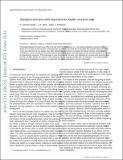Starspots and spin-orbit alignment for Kepler cool host stars
Author(s)
Sanchis Ojeda, Roberto; Winn, Joshua Nathan; Fabrycky, Daniel C.
DownloadWinn_Starspots and.pdf (1.055Mb)
OPEN_ACCESS_POLICY
Open Access Policy
Creative Commons Attribution-Noncommercial-Share Alike
Terms of use
Metadata
Show full item recordAbstract
The angle between the spin axis of the host star and the orbit of its planets (i.e., the stellar obliquity) is precious information about the formation and evolution of exoplanetary systems. Measurements of the Rossiter-McLaughlin effect revealed that many stars that host a hot-Jupiter have high obliquities, suggesting that hot-Jupiter formation involves excitation of orbital inclinations. In this contribution we show how the passage of the planet over starspots can be used to measure the obliquity of exoplanetary systems. This technique is used to obtain – for the first time – the obliquity of a system with several planets that lie in a disk, Kepler-30, with the result that the star has an obliquity smaller than 10 degrees. The implications for the formation of exoplanetary systems, in particular the hot-Jupiter population, are also discussed.
Date issued
2013-02Department
Massachusetts Institute of Technology. Department of PhysicsJournal
Astronomische Nachrichten
Publisher
John Wiley & Sons, Inc
Citation
Sanchis-Ojeda, R., J. N. Winn, and D. C. Fabrycky. "Starspots and spin-orbit alignment for Kepler cool host stars." (February 2013), Volume 334, Issue 1-2, pages 180-183.
Version: Original manuscript
ISSN
0004-6337
1521-3994
